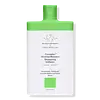What's inside
What's inside
 Key Ingredients
Key Ingredients

No key ingredients
 Benefits
Benefits

 Concerns
Concerns

 Ingredients Side-by-side
Ingredients Side-by-side

Water
Skin ConditioningSodium Methyl Cocoyl Taurate
CleansingCocamidopropyl Hydroxysultaine
CleansingDecyl Glucoside
CleansingGlycol Distearate
EmollientSodium Lauroyl Lactylate
EmulsifyingSodium Cocoyl Glycinate
CleansingMaltooligosyl Glucoside
Skin ConditioningLinoleamidopropyl Pg-Dimonium Chloride Phosphate
Lauryl/Myristyl Polyricinoleate
EmollientBehenyl Alcohol
EmollientLaureth-23
CleansingSodium Cocoyl Isethionate
CleansingCeteareth-60 Myristyl Glycol
EmulsifyingCassia Hydroxypropyltrimonium Chloride
Hydrogenated Starch Hydrolysate
HumectantFurcellaria Lumbricalis Extract
Skin ConditioningPolyquaternium-47
Skin ConditioningPhytantriol
HumectantHydroxyacetophenone
AntioxidantPPG-2 Hydroxyethyl Cocamide
EmulsifyingLaureth-4
EmulsifyingPEG-150 Pentaerythrityl Tetrastearate
EmulsifyingTrisodium Ethylenediamine Disuccinate
Sodium Benzoate
MaskingCitric Acid
BufferingParfum
MaskingLinalool
PerfumingHexyl Cinnamal
PerfumingCitronellol
PerfumingLimonene
PerfumingWater, Sodium Methyl Cocoyl Taurate, Cocamidopropyl Hydroxysultaine, Decyl Glucoside, Glycol Distearate, Sodium Lauroyl Lactylate, Sodium Cocoyl Glycinate, Maltooligosyl Glucoside, Linoleamidopropyl Pg-Dimonium Chloride Phosphate, Lauryl/Myristyl Polyricinoleate, Behenyl Alcohol, Laureth-23, Sodium Cocoyl Isethionate, Ceteareth-60 Myristyl Glycol, Cassia Hydroxypropyltrimonium Chloride, Hydrogenated Starch Hydrolysate, Furcellaria Lumbricalis Extract, Polyquaternium-47, Phytantriol, Hydroxyacetophenone, PPG-2 Hydroxyethyl Cocamide, Laureth-4, PEG-150 Pentaerythrityl Tetrastearate, Trisodium Ethylenediamine Disuccinate, Sodium Benzoate, Citric Acid, Parfum, Linalool, Hexyl Cinnamal, Citronellol, Limonene
Water
Skin ConditioningSodium Lauroyl Methyl Isethionate
CleansingCocamidopropyl Betaine
CleansingSodium Methyl Oleoyl Taurate
CleansingSodium Cocoyl Isethionate
CleansingCoconut Alkanes
EmollientSclerocarya Birrea Seed Oil
HumectantArgania Spinosa Kernel Oil
EmollientPassiflora Edulis Seed Oil
EmollientPlukenetia Volubilis Seed Oil
EmollientPrunus Amygdalus Dulcis Oil
Skin ConditioningRosa Canina Fruit Oil
EmollientGlycerin
HumectantSodium PCA
HumectantCaprylic/Capric Triglyceride
MaskingHelianthus Annuus Seed Oil
EmollientPanthenol
Skin ConditioningGlycol Distearate
EmollientSodium Lactate
BufferingEquisetum Arvense Extract
AstringentPCA
HumectantAlanine
MaskingArginine
MaskingGlycine
BufferingHistidine
HumectantIsoleucine
Skin ConditioningPhenylalanine
MaskingProline
Skin ConditioningSerine
MaskingThreonine
Valine
MaskingAdansonia Digitata Seed Extract
Skin ConditioningTrisodium Ethylenediamine Disuccinate
Prunus Amygdalus Dulcis Seed Extract
Skin ConditioningCitric Acid
BufferingAspartic Acid
MaskingPolyquaternium-10
Polyquaternium-7
Laureth-4
EmulsifyingCoco-Caprylate/Caprate
EmollientCaprylyl Glycol
EmollientSodium Benzoate
MaskingChlorphenesin
AntimicrobialPhenoxyethanol
PreservativeWater, Sodium Lauroyl Methyl Isethionate, Cocamidopropyl Betaine, Sodium Methyl Oleoyl Taurate, Sodium Cocoyl Isethionate, Coconut Alkanes, Sclerocarya Birrea Seed Oil, Argania Spinosa Kernel Oil, Passiflora Edulis Seed Oil, Plukenetia Volubilis Seed Oil, Prunus Amygdalus Dulcis Oil, Rosa Canina Fruit Oil, Glycerin, Sodium PCA, Caprylic/Capric Triglyceride, Helianthus Annuus Seed Oil, Panthenol, Glycol Distearate, Sodium Lactate, Equisetum Arvense Extract, PCA, Alanine, Arginine, Glycine, Histidine, Isoleucine, Phenylalanine, Proline, Serine, Threonine, Valine, Adansonia Digitata Seed Extract, Trisodium Ethylenediamine Disuccinate, Prunus Amygdalus Dulcis Seed Extract, Citric Acid, Aspartic Acid, Polyquaternium-10, Polyquaternium-7, Laureth-4, Coco-Caprylate/Caprate, Caprylyl Glycol, Sodium Benzoate, Chlorphenesin, Phenoxyethanol
Ingredients Explained
These ingredients are found in both products.
Ingredients higher up in an ingredient list are typically present in a larger amount.
Citric Acid is an alpha hydroxy acid (AHA) naturally found in citrus fruits like oranges, lemons, and limes.
Like other AHAs, citric acid can exfoliate skin by breaking down the bonds that hold dead skin cells together. This helps reveal smoother and brighter skin underneath.
However, this exfoliating effect only happens at high concentrations (20%) which can be hard to find in cosmetic products.
Due to this, citric acid is usually included in small amounts as a pH adjuster. This helps keep products slightly more acidic and compatible with skin's natural pH.
In skincare formulas, citric acid can:
While it can provide some skin benefits, research shows lactic acid and glycolic acid are generally more effective and less irritating exfoliants.
Most citric acid used in skincare today is made by fermenting sugars (usually from molasses). This synthetic version is identical to the natural citrus form but easier to stabilize and use in formulations.
Read more about some other popular AHA's here:
Learn more about Citric AcidGlycol Distearate serves as a pearlizing or opacifying agent in cosmetic products.
It's often included in cleansers and haircare products to give them a lustrous or shimmering appearance.
It is derived from stearic acid, a natural fatty acid commonly found in vegetable oils and animal fats.
Glycol Distearate isn't fungal acne safe.
Learn more about Glycol DistearateLaureth-4 is created by reacting ethylene oxide with Lauryl Alcohol. It is a surfactant and emulsifier.
Surfactants reduce the surface tension of ingredients so they can mix better. Emulsifiers prevent ingredients such as oil and water from separating.
Sodium Benzoate is a preservative. It's used in both cosmetic and food products to inhibit the growth of mold and bacteria. It is typically produced synthetically.
Both the US FDA and EU Health Committee have approved the use of sodium benzoate. In the US, levels of 0.1% (of the total product) are allowed.
Sodium benzoate works as a preservative by inhibiting the growth of bacteria inside of cells. It prevents the cell from fermenting a type of sugar using an enzyme called phosphofructokinase.
It is the salt of benzoic acid. Foods containing sodium benzoate include soda, salad dressings, condiments, fruit juices, wines, and snack foods.
Studies for using ascorbic acid and sodium benzoate in cosmetics are lacking, especially in skincare routines with multiple steps.
We always recommend speaking with a professional, such as a dermatologist, if you have any concerns.
Learn more about Sodium BenzoateSodium cocoyl isethionate is a natural ingredient from coconut oil. It is an ultra gentle cleanser that gives a nice foam without drying the skin or impacting the skin barrier.
The amount of foam created depends on the amount of sodium cocoyl isethionate used in the product.
This ingredient also helps improve the spreadability of a product.
Learn more about Sodium Cocoyl IsethionateTrisodium Ethylenediamine Disuccinate is used to help stabilize a product.
It is a chelating agent, meaning it helps prevent metal ions from binding to other ingredients. This prevents unwanted reactions in products. Metal ions can come into a product via the water ingredient. They are found in trace amounts and are not known to be harmful.
Water. It's the most common cosmetic ingredient of all. You'll usually see it at the top of ingredient lists, meaning that it makes up the largest part of the product.
So why is it so popular? Water most often acts as a solvent - this means that it helps dissolve other ingredients into the formulation.
You'll also recognize water as that liquid we all need to stay alive. If you see this, drink a glass of water. Stay hydrated!
Learn more about Water